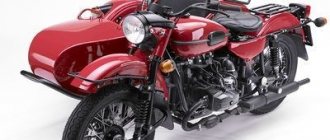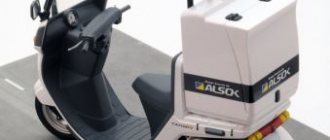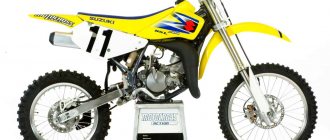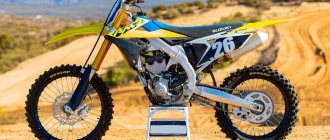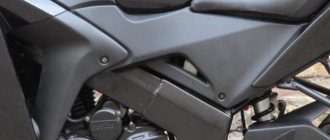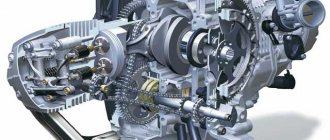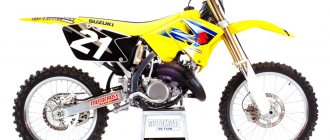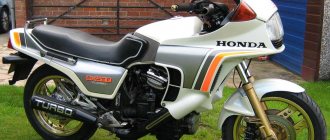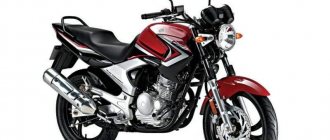Metric marking system
The metric marking system is found in our country much more often than others. In its classic form, it is approximately the following code: 120/70 - Z17 M/C. All its elements are in strict order. Let's look at each of them in more detail.
The first number (120 in our case) means the width of the tire in a straight line from edge to edge. In the metric marking system, it is measured in millimeters.
The second number (70 in the example) indicates the height of the tire profile, taking into account the tread. It is expressed as a percentage of the tire width in mm.
Using a tire with a rim width or height that is not specified by the motorcycle manufacturer may result in loss of cornering dynamics, increased fuel consumption and shortened tire life.
Next come the alphabetic Latin designations. The first letter (Z) means that this is a high-speed tire and can be used at speeds above 240 km/h.
The letter W is a speed index, that is, an indicator, exceeding which has a negative effect on the condition of the tire and reduces its service life. Latin speed index designations are international and are used in all types of tire markings.
Below we provide a summary table of speed indices.
Speed indices
| Designation | km/h | mph |
| B | 50 | 31 |
| C | 60 | 37 |
| D | 65 | 40 |
| E | 70 | 44 |
| F | 80 | 50 |
| G | 90 | 56 |
| J | 100 | 62 |
| K | 110 | 68 |
| L | 120 | 74 |
| M | 130 | 81 |
| N | 140 | 87 |
| P | 150 | 93 |
| Q | 160 | 100 |
| R | 170 | 106 |
| S | 180 | 112 |
| T | 190 | 118 |
| U | 200 | 124 |
| H | 210 | 130 |
| V/VB | up to 240 | up to 149 |
| (V)/(VB) | more than 240 | more than 149 |
| W | up to 270 | up to 168 |
| (W) | more than 270 | more than 168 |
| ZR | more than 240 | more than 149 |
The last number (in our case 17) is the diameter of the rim. Even in the metric marking system, this parameter is measured in inches. You won't be able to fit a tire designed for a 16-inch rim onto a 17-inch rim (and even if you do, it won't end well).
The letter combination M/C indicates that the rubber is intended specifically for motorcycles.
In addition to the main code (120/70 - Z17 M/C), other information can be encrypted in different parts of the bus.
First of all, we need to talk about the load index (see figure). It shows the maximum weight that the tire can support when fully inflated. The table of load indexes is presented at the bottom of the page.
A special arrow (sometimes accompanied by the words Wheel Rotation) indicates the direction of rotation.
The code TUBE or TT means the tire must be used with a tube only, while TUBELESS or TL means it is tubeless.
On some tires you can find the abbreviation DOT. It is applied to models and complies with the safety standards of the US Department of Transportation. The abbreviation EUCX means the same certificate issued by one of the European Union countries.
The letter B in a circle is a sign of official approval based on test results within the framework of UNECE rules, the number next to it is the country where the test was carried out.
The date of manufacture of the tire can be understood by the last four digits in the oval, for example 4207 - week 42 of 2007.
Load indices
| Designation | kg | Designation | kg | Designation | kg | Designation | kg |
| 20 | 80 | 37 | 128 | 54 | 212 | 71 | 345 |
| 21 | 82.5 | 38 | 132 | 55 | 218 | 72 | 355 |
| 22 | 85 | 39 | 136 | 56 | 224 | 73 | 365 |
| 23 | 87.5 | 40 | 140 | 57 | 230 | 74 | 375 |
| 24 | 90 | 41 | 145 | 58 | 236 | 75 | 387 |
| 25 | 92.5 | 42 | 150 | 59 | 243 | 76 | 400 |
| 26 | 95 | 43 | 155 | 60 | 250 | 77 | 412 |
| 27 | 97 | 44 | 160 | 61 | 257 | 78 | 425 |
| 28 | 100 | 45 | 165 | 62 | 265 | 79 | 437 |
| 29 | 103 | 46 | 170 | 63 | 272 | 80 | 450 |
| 30 | 106 | 47 | 175 | 64 | 280 | 81 | 462 |
| 31 | 109 | 48 | 180 | 65 | 290 | 82 | 475 |
| 32 | 112 | 49 | 185 | 66 | 300 | 83 | 487 |
| 33 | 115 | 50 | 190 | 67 | 307 | 84 | 500 |
| 34 | 118 | 51 | 195 | 68 | 315 | 85 | 515 |
| 35 | 121 | 52 | 200 | 69 | 325 | 86 | 530 |
| 36 | 125 | 53 | 206 | 70 | 335 | 87 | 545 |
You can see all the listed metric marking codes for motor tires and comments from professionals on them in the video below.
Motorcycle tire marking
Let's start with a visual representation: The main and first parameter when selecting a tire is its size. Below we will look at the most common (Metric) motorcycle tire labeling system. As a rule, this marking looks something like this: 120/70 ZR17 (73W) TL Rear 120/70 ZR17 (73W) TL Rear - the first number indicates the tire width in mm - in this case 120 mm; 120/70 ZR17 (73W) TL Rear - second - the height of the tire profile taking into account the tread in % of its width - in this case 70% of 120 mm, i.e. it turns out 84 mm; 120/70 ZR17 (73W) TL Rear - the last number - indicates the mounting diameter of the tire in inches; in our case, this tire is designed for installation on wheels with a diameter of 17 inches.
Diagram for clarity: As you may have noticed, this marking also contains the letters “Z” and “R”. 120/70 ZR17 (73W) TL Rear - The first letter - “Z” - indicates the index of a high-speed tire that can be used at speeds above 240 km/h.
Below is a table of speed index decoding:
| Speed index | F | G | J | K | L | M | N | P | Q | R | S | T | U | H | V | W | Y | VR | ZR | (W) |
| Speed, km/h | 80 | 90 | 100 | 110 | 120 | 130 | 140 | 150 | 160 | 170 | 180 | 190 | 200 | 210 | 240 | 270 | 300 | >210 | >240 | >270 |
120/70 ZR17 (73W) TL Rear - the second letter - “R” - indicates the type of tire construction.
In this case, “R” (RADIAL) is radial. Instead of the letter “R” there can be “-” or “B” - they indicate a diagonal tire design. The main difference between bias-ply tires and radial tires is that in a bias-ply tire the threads in the carcass are “stretched” diagonally, from rim to rim, and in each subsequent layer the direction of the diagonals is opposite to the previous one (overlapping). Based on this, there can only be an even number of layers in the carcass of a diagonal tire (usually there are four of them). In a radial tire, the textile threads of the carcass “run” strictly perpendicular to the track of movement - from rim to rim, which gives manufacturers a wide field for maneuver with the number of layers.
The advantages of a radial tire are that it holds its shape better, which directly affects handling and driving safety. This is precisely one of the main reasons why, for example, only radial tires are produced for sportbikes. Another consequence of shape stability is better traction and more uniform tread wear (such a tire, all other things being equal, will last longer).
At the same time, a bias-ply tire has much stronger sidewalls that are much less susceptible to cuts, punctures and scuffing. In addition, the sidewalls of diagonal tires, unlike radial tires, are completely repairable - in most cases, when a radial tire is generally subject to disposal, a diagonal tire can still be saved and continue to be used. In addition, bias-ply tires better soften the shock loads transmitted to the motorcycle when driving on poor quality roads or off-road.
120/70 ZR17 (73W) TL Rear – further, in the tire marking, load and speed indicators are indicated. In this case, “73” is the load index (a parameter corresponding to the load that the rubber can withstand at maximum internal air pressure). And “W” denotes the speed index (an indicator indicating the maximum design speed at which a given tire can be operated). The table with the breakdown of speed indices was given above.
Table "Load indices"
120/70 ZR17 (73W) TL Rear – the “TL” marking means that the tire is tubeless (TUBLESS). If the designation “TT” is used instead of “TL”, this means a tube type of rubber (TUBE TYPE).
120/70 ZR17 (73W) TL Rear – “Rear” - designation of a tire intended for the rear wheel; “Front Wheel” or simply “F” - the tire is installed on the front wheel. There are also universal tires that can be installed on both the front and rear axles.
Additional abbreviations for tire markings:
M/C
- an abbreviation for motorcycle, means that it belongs to motorcycle tires (indicated if the tire has “car” dimensions.
M.B.S.
- a type of cord consisting of Kevlar threads designed to strengthen the structure (limit tire deformation at high speed);
ND
(Non Directional) - non-directional tire;
NHS
(Non Highway Service) - tires not intended for highway use;
N.W.S.
(Narrow White Stripe) - designation of a thin white stripe on the sidewall of the tire;
REINF
(Reinforced) - a motorcycle tire of reinforced design with additional layers of cord;
S.A.G.
(Super All Grip) - all-terrain tires;
SL
(Limited Service) - limited use;
XL
(eXtra Load) - tire with increased load;
WW
(White Wall) - designation of a white insert (stripe) on the sidewall of a motorcycle tire;
Also in the designation of rubber, additional letters (O), (H), (GL), etc. are used, which indicate the tire’s specification for a specific motorcycle model or indicate its use in the original factory equipment.
Tire production date
According to the regulations of the US Department of Transportation (DOT - Department Of Transportation - this organization, among other things, certifies tires for sale in the US market), the production date of tires must be applied to the side surface of the tire, and in a clearly marked form. Since 2000, this is a four-digit number in an oval, the first two digits of which indicate the serial number of the week of the year, and the last two digits indicate the year of production. That is, for example, coding 3714 on the sidewall of a tire means that the tire was made in the 37th week of 2014. This rule applies to all tires from all manufacturers that target their products, including the US market (DOT certification is required for the US market). In fact, all leading tire manufacturers follow this rule, regardless of the geography of tire distribution.
Until 2000, the production date on tires was indicated by a three-digit code (the first two digits are the week number, the last is the year code), but today there are very few such tires left.
Various tire marking systems for motorcycles
There are several types of tire markings (width, profile height and internal diameter): - Metric system (example: 180/55 ZR17; 120/70 -17; 130/80 B18); — Alpha system (example: MT90S-16; MT90HB-16); — Standard in inches (example: 3.25H-19); — Low profile in inches (example: 4.25/85H-18; 4.60S-16).
Size chart for all motorcycle tire marking systems:
You can also use this table with recommendations for rim width (left) - permissible wheel width (right)
Next, we’ll take a closer look at each labeling system.
1. Metric – this system was considered by us at the very beginning of the article;
2. Alpha system (Alpha)
Example: MT90S-16.
This alphanumeric system is usually used to mark tires for touring motorcycles.
Let's look at it using the specific example of MT90S-16.
The first letter “M” means that this tire is a motorcycle tire (Motorcycle Tire).
“T” – Designation of tire width; “90” is the height of the tire along the profile as a percentage of the width; “S” – speed index; The very last number “16” indicates the wheel diameter in inches.
3. Standard inch
Example: 3.25H-19.
Basically, this system was used mainly in 1990-1999.
“3.25” is the section width of a motorcycle tire, expressed in inches.
This marking does not have a separate designation for the profile height, since it is assumed that the height is equal to the width of the tire. Those. the profile is square and its height is also “3.25” inches (or 100% of the width).
So “3.25” inches is approximately 83 mm.
The letter “H” is the speed index, and “19” is the wheel diameter in inches on which the tire can be mounted.
4. Low-profile inch (second name – “82% marking system”)
This system marks tires with a low profile, which are extremely rare. (Low profile tires are tires whose profile height is less than the width in specified proportions and with a fixed width).
The second name “82% marking system” arose due to the fact that if the ratio of profile height to width is not indicated, then it is 82%.
Example: 4.25/85H-18; 4.60S-16
“4.25” is the width in inches, and “85” is the percentage of height to width of the tire. “H” is the speed index, and “18” is the tire diameter in inches. Primary data source mgmoto.ru
Alpha marking system
This type of tire marking is used infrequently and is used mainly for tourist tires. Let's look at a specific example: MT90S-16.
- M - rubber, intended for motorcycles.
- T – tire width (the corresponding value in millimeters can be seen in the summary table below).
- 90 is the height of the tire profile, which is expressed as a percentage of its width.
- S – speed index.
- 16 – wheel diameter (in inches).
Motor tires: characteristics, types, types
- Sports. In this case, sports driving means high-speed driving on as smooth surfaces as possible. Accordingly, all such tires have a high speed index - not lower than W (270 km/h). In addition, sports motorcycles are characterized by relatively low weight; As a result of this (as well as for some other reasons), the rubber of this direction is made radial (see “Design”). Note that such models are characterized by a shallow tread pattern. This provides excellent traction on quality, smooth surfaces, but on uneven, wet or muddy roads, driving on these tires requires caution. This is especially true for track sports tires without any tread at all, the so-called slicks, which are placed in a separate section and are intended exclusively for driving in dry weather on the race track. It is strictly forbidden to use such tires on city roads, for your own safety. - Road. Tires designed, as the name suggests, for driving on regular roads with a hard (but not necessarily perfectly smooth) surface. Such models can be produced for a wide variety of equipment - from heavy choppers and cruisers to miniature scooters. However, in all cases, road tires are characterized by a fairly high load index, which allows them to easily carry quite a large weight of the motorcycle and contact with uneven surfaces on the road. Most road tires are bias-ply, but radial tires are also available. The speed index of such tires is lower than that of sports tires (although there are models for 270 km/h); In addition, even the most sleek models have a fairly deep tread pattern, which ensures effective moisture removal and reliable contact with uneven roads.
— Cross-country. A specialized type of motorcycle tire, created exclusively for off-road driving and intended, in accordance with the name, for use in motocross. The most noticeable external feature of these tires is the deep tread pattern with characteristic ridges that improve traction.
— Enduro. Initially, enduro was a type of motorcycle racing in which riders had to ride on different types of terrain - from smooth paved roads to complete off-road conditions. This determined the main features of tires for this purpose: they are a cross between road and motocross tires (see above) and are suitable for both highways and rough terrain. Of course, in terms of speed characteristics, such tires are inferior to road ones, and in cross-country ability - to cross-country ones; However, in cases where versatility is more important than advanced performance, enduro tires are simply irreplaceable. Note that in appearance such models can be similar to both motocross models (with noticeable protrusions) and road models (relatively smooth, with a small number of grooves). In the first case, a special rubber composition is usually used, which ensures a sufficient level of grip on hard surfaces; in the second, various design tricks are used to increase cross-country ability.
- Scrambler. Universal tires for asphalt surfaces and moderate off-road conditions. Their tread pattern is aggressive enough to conquer country roads and at the same time quite smooth for prolonged driving on hard road surfaces. Scrambler motorcycles began their journey as road models, modified by manufacturers or owners for off-road riding. The closest relatives of scrambler-type motorcycle tires are enduro tires with a more “evil” tread pattern.
Low profile in inches
As the name suggests, it is used for low-profile tires. Example: 4.25/85H-18. The first number is the tire width in inches, the second is the profile height expressed as a percentage of the width, H is the speed index, 18 is the rim diameter.
Summary table of tire sizes in various marking systems
| Acceptable rim widths | Metric | Alpha | Standard in inches | Low profile in inches |
| 1.60, 1.85 | 70 | MG | 2.75 | — |
| 1.60, 1.85 | 80 | M.H. | 3.00 | 3.60 |
| 1.85, 2.15 | 90 | MJ | 3.25 | 3.60 |
| 1.85, 2.15 | 90 | M.L. | 3.50 | 4.10 |
| 2.15, 2.50 | 100 | MM | 3.75 | 4.10 |
| 2.15, 2.50, 2.75 | 110 | MN | 4.00 | 4.60 |
| 2.15, 2.50, 2.75 | 110 | MP | 4.25 | 4.25/85 |
| 2.15, 2.50, 2.75 | 120 | M.R. | 4.50 | 4.25/85 |
| 2.15, 2.50, 2.75 | 120 | MS | 4.75 | 5.10 |
| 2.50, 2.75, 3.00 | 130 | M.T. | 5.00 | 5.10 |
| 2.75, 3.00, 3.50 | 140 | M.U. | 5.50 | — |
| 3.50, 4.00 | 150 | MV | 6.00 | — |
| 4.00, 4.50 | 160 | — | 6.25 | — |
Motorcycle tire repair and maintenance
Experts recommend not repairing motorcycle tires at all, and disposing of them immediately after a puncture. It is allowed to patch the tube if there are no obvious cracks or cuts in the tire. Otherwise, you need to buy a new tire, otherwise it can be fraught with negative consequences, including a serious accident on the road.
If you have already repaired tires once, it is not recommended to drive at high speeds - in such cases it is forbidden to exceed the barrier of 100 km/h.
Shelf life of motor tires
All motorcycle tires have a special 4-digit stamp. The numbers indicated indicate the week number and year in which it was released. If the tires are 3-4 years old, they need to be changed urgently.
You also need to inspect the tread pattern. If you notice even small cracks, it's time to buy a new tire. In addition, all tires have wear marks, which appear as small bumps inside the tread channels. If you see these bumps without a magnifying glass or magnifier, this is a clear sign that the tire has already worn out. This is also a good reason to replace the tires.
Remember that your life and the lives of the passengers behind you depend on the quality, reliability and serviceability of motorcycle tires. That's why we strongly recommend that you regularly check the condition of your tires before driving.
Buy only high-quality tires, drive with pleasure and safely!
